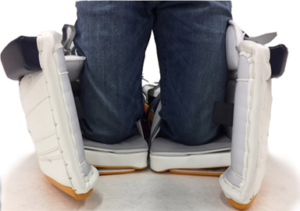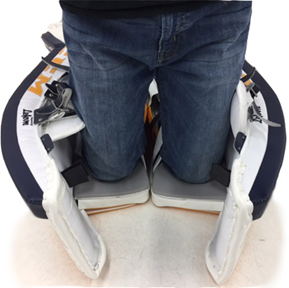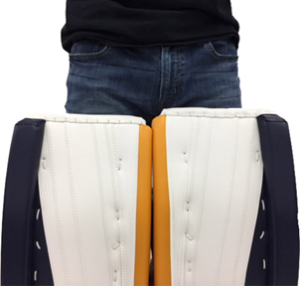Goal Pads
Goal pads are sized numerically rather than by standard “Small, Medium, Large, etc.”. This number is the measurement from the toe of the pads to the top of the thigh, in inches. However, nearly all pads for the past decade come with a standard +1 or +2 sizing. This refers to the additional height added to the top of the thigh on the pad. For example, a 34+1, 34+2, and 34+3 will all have the identical shin length and knee placement, but the thigh length above the knee increases. This allows for a more personalized fit for goaltenders with different leg shapes and sizes.
The 2 major keys when fitting a goal pad are as follows:
1.Knee placement. The modern goaltender is taught the butterfly save and style from early on. Because of this, the goaltender will spend a lot of time on their knees, and ensuring their knee is properly placed in the cradle will reduce the risk of a goaltender injuring their knees when dropping to the ice. To test sizing, have the goaltender do up all the straps on the pads, exactly how they would in a game. Have the goaltender drop to a butterfly, and hold the position. While they are still, ask them to gently click their heels together, to allow for a better view of the knee placement. The middle of the goaltender’s knees should land in the middle of the knee cradle, allowing for optimal fit and weight distribution. If the goaltender’s knees are towards the top of the knee cradle, they will outgrow the pads in a short period of time. To allow for growth room, the goaltender’s knees should land in the bottom 1/3 of the cradle, no lower. If the knee is too low, it will slide out of the cradle and slam against the ice.
2.Thigh height. Have the goaltender stand with their legs together for this measurement. This is a more personal-feel fit, as some goaltenders will prefer a taller pad while others may want shorter. An ideal fit is 2-3 inches above the middle of the thigh. Any higher and the pad will come up into the bend of the leg/bottom of crotch and will restrict skating movement. If the pad comes below the middle of the thigh, the five-hole may not be covered and the knees could be exposed to sticks and pucks.
Strap tightness is entirely preference-based. Historically, the pads were to be tight to the goaltender’s legs in order to move easier. However, currently goaltenders are loosening their straps to increase pad rotation in the butterfly. A good rule of thumb to follow is that the boot strap on the bottom of the pads should be loose in order to allow skate movement, the calf straps can be either snug or loose, and the knee/thigh straps should be loose to allow rotation.



